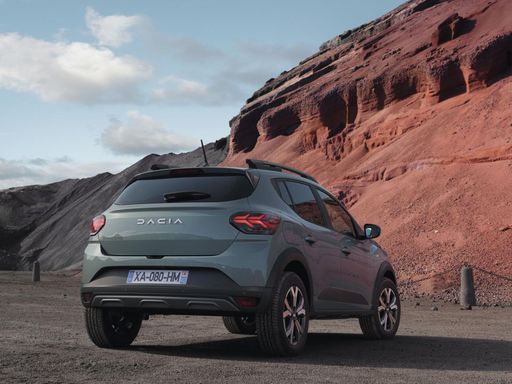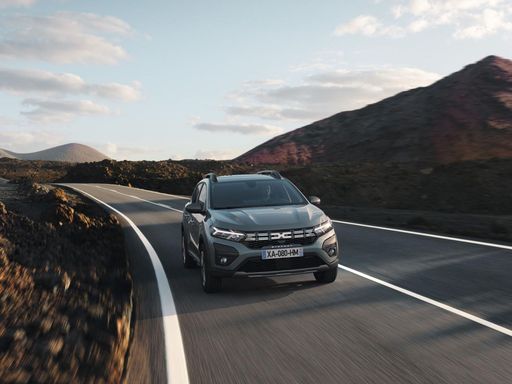Dacia Sandero VS Maxus eTERRON 9 – Specs, Efficiency & Price Comparison
Which model is the better choice – the Dacia Sandero or the Maxus eTERRON 9? We compare performance (110 HP vs 442 HP), boot capacity (328 L vs ), efficiency (5.30 L vs 26.70 kWh), and of course, the price (10700 £ vs 64200 £).
Find out now which car fits your needs better!
The Dacia Sandero (Hatchback) is powered by a Petrol or LPG engine and comes with a Manuel or Automatic transmission. In comparison, the Maxus eTERRON 9 (Pickup) features a Electric engine and a Automatic gearbox.
When it comes to boot capacity, the Dacia Sandero offers 328 L, while the Maxus eTERRON 9 provides – depending on what matters most to you. If you’re looking for more power, you’ll need to decide whether the 110 HP of the Dacia Sandero or the 442 HP of the Maxus eTERRON 9 suits your needs better.
There are also differences in efficiency: 5.30 L vs 26.70 kWh. In terms of price, the Dacia Sandero starts at 10700 £, while the Maxus eTERRON 9 is available from 64200 £.
Compare all the key specs now and find out which model fits your lifestyle best!
Dacia Sandero
The Dacia Sandero stands out as an exceptional value in the hatchback market, offering a blend of practicality and affordability that appeals to a wide range of drivers. Its understated design is complemented by a surprisingly spacious interior, providing ample comfort and functionality for everyday use. With impressive fuel efficiency and a solid reputation for reliability, the Sandero remains a popular choice for those seeking a no-nonsense vehicle without sacrificing essential modern features.
details @ dacia.at
@ dacia.at
 @ dacia.at
@ dacia.at
 @ dacia.at
@ dacia.at
Maxus eTERRON 9
The eTERRON 9 stands out with its striking design and innovative features, making it a compelling choice for eco-conscious drivers. Its spacious interior and advanced technology provide a seamless driving experience that prioritizes both comfort and connectivity. With impressive efficiency and an array of smart capabilities, the eTERRON 9 is redefining what modern electric vehicles can offer.
details

|
|
|
|
|
Costs and Consumption |
|
|---|---|
|
Price
10700 - 16700 £
|
Price
64200 - 66800 £
|
|
Consumption L/100km
5.3 - 7.1 L
|
Consumption L/100km
-
|
|
Consumption kWh/100km
-
|
Consumption kWh/100km
26.70 kWh
|
|
Electric Range
-
|
Electric Range
430 km
|
|
Battery Capacity
-
|
Battery Capacity
-
|
|
co2
105 - 140 g/km
|
co2
0 g/km
|
|
Fuel tank capacity
32 - 50 L
|
Fuel tank capacity
-
|
Dimensions and Body |
|
|---|---|
|
Body Type
Hatchback
|
Body Type
Pickup
|
|
Seats
5
|
Seats
5
|
|
Doors
5
|
Doors
4
|
|
Curb weight
1089 - 1209 kg
|
Curb weight
2925 - 2955 kg
|
|
Trunk capacity
328 L
|
Trunk capacity
-
|
|
Length
4088 - 4099 mm
|
Length
5500 mm
|
|
Width
1848 mm
|
Width
1997 mm
|
|
Height
1499 - 1535 mm
|
Height
1860 mm
|
|
Payload
404 - 436 kg
|
Payload
545 - 575 kg
|
Engine and Performance |
|
|---|---|
|
Engine Type
Petrol, LPG
|
Engine Type
Electric
|
|
Transmission
Manuel, Automatic
|
Transmission
Automatic
|
|
Transmission Detail
Schaltgetriebe
|
Transmission Detail
-
|
|
Drive Type
Front-Wheel Drive
|
Drive Type
All-Wheel Drive
|
|
Power HP
67 - 110 HP
|
Power HP
442 HP
|
|
Acceleration 0-100km/h
10 - 16.7 s
|
Acceleration 0-100km/h
5.80 s
|
|
Max Speed
158 - 183 km/h
|
Max Speed
190 km/h
|
|
Torque
95 - 200 Nm
|
Torque
700 Nm
|
|
Number of Cylinders
3
|
Number of Cylinders
-
|
|
Power kW
49 - 81 kW
|
Power kW
325 kW
|
|
Engine capacity
999 cm3
|
Engine capacity
-
|
General |
|
|---|---|
|
Model Year
2024 - 2025
|
Model Year
2025
|
|
CO2 Efficiency Class
D, C, E
|
CO2 Efficiency Class
A
|
|
Brand
Dacia
|
Brand
Maxus
|
Dacia Sandero
The Dacia Sandero: An Affordable Gem in the Automotive World
The Dacia Sandero has consistently positioned itself as a quintessential choice for budget-conscious buyers who seek practicality without sacrificing quality. As an integral part of Dacia's line-up, the Sandero offers a compelling blend of efficiency, robustness, and value for money. With the 2024 model, Dacia continues to enhance its offerings with a range of engine options and trim levels to satisfy diverse customer needs.
Innovative Engine Options
The latest Dacia Sandero boasts a variety of engine options, including petrol and gas variants. The range covers outputs from 67 PS to 110 PS, providing flexibility for different driving preferences. For those prioritising fuel economy, the SCe 65 petrol engine offers a commendable consumption figure of 5.3 litres per 100 km. Meanwhile, the TCe 100 ECO-G engine, running on gas, balances efficiency and performance with an output of 101 PS and a consumption of 6.5 litres per 100 km.
Efficiency and Driving Dynamics
With the Dacia Sandero, efficiency is key. The innovative TCe 90 petrol engine, available with both manual and automatic transmissions, ensures a smooth ride combined with competitive fuel efficiency - approximately 5.2 to 5.7 litres per 100 km. Additionally, the Sandero maintains impressive CO2 emissions ranging from 105 to 139 g/km, reinforcing its suitability for eco-conscious drivers.
Practical Design and Spacious Interiors
The Dacia Sandero’s design speaks to the needs of modern urban and suburban drivers. As a five-door hatchback, it provides enormous practicality alongside a spacious interior. The cabin comfortably seats five passengers and offers a generous 328-litre boot, which can easily accommodate everyday luggage and more. Its exterior dimensions, including a length of 4088 to 4099 mm and a width of 1848 mm, enable the Sandero to navigate city streets with ease.
Safety and Technological Features
Safety remains a priority for Dacia, and the Sandero is equipped with a host of features to ensure peace of mind for drivers and passengers. Options such as the latest braking technologies, stability control, and multiple airbags come standard across various trim levels. Technologically, the Sandero incorporates features like a modern infotainment system and essential connectivity options to enhance the driving experience.
Concluding Thoughts
The Dacia Sandero represents a remarkable blend of affordability, efficiency, and practicality, solidifying its place in the competitive compact car segment. Whether it's daily city commutes or longer journeys, the Sandero offers a version tailored to meet a wide array of demands and preferences, embodying Dacia’s commitment to delivering more for less. With competitive pricing and the promise of a reliable, economical drive, the 2024 Sandero continues to resonate with those seeking value in their automotive investment.
Maxus eTERRON 9
The automotive industry is witnessing a remarkable transformation as electric vehicles (EVs) become more mainstream. One of the standout entrants in this rapidly evolving marketplace is the Maxus eTERRON 9, an electric pickup that combines cutting-edge technology, impressive performance metrics, and an appealing design. This model, tailored for modern consumers and businesses alike, is revolutionizing the way we view utility in an EV format.
Stunning Performance Metrics
The eTERRON 9 is a powerhouse of performance, boasting an impressive 442 horsepower generated by its electric engine. This output allows for exhilarating acceleration, enabling it to go from 0 to 100 km/h in just 5.8 seconds. The automatic transmission paired with the all-wheel-drive system ensures a smooth and dynamic driving experience, making it as adept at navigating city streets as it is on rugged terrain.
Innovative Efficiency
In a world increasingly focused on sustainability, the Maxus eTERRON 9 stands out with its impressive efficiency, consuming only 26.7 kWh per 100 km. This efficiency does not come at the cost of range; the eTERRON 9 is capable of covering up to 430 km on a single charge, making it suitable for both daily commutes and longer journeys. Its CO2 efficiency class of A further highlights its commitment to reducing emissions, with a remarkable 0 g/km CO2 output, ensuring environmentally conscious driving.
Design and Practicality
The exterior dimensions of the eTERRON 9 are quite grand, measuring 5500 mm in length, 1997 mm in width, and 1860 mm in height. This gives the pickup a commanding presence on the road, while also offering a spacious interior. With a seating capacity for five, the cabin is designed for comfort and utility, ensuring that passengers enjoy ample space even on longer trips. The eTERRON 9 also features four doors, thereby maximizing accessibility for all occupants.
Payload and Versatility
One of the eTERRON 9’s standout features is its impressive payload capacity, ranging from 545 to 575 kg, depending on the specification. This makes it an ideal choice for businesses needing a reliable vehicle for transporting goods, as well as for outdoor enthusiasts looking to carry extra gear on their adventures. The combination of electric power and significant payload capacity means that the eTERRON 9 doesn't just perform well—it adapts to a variety of practical situations.
Technological Innovations
The technological suite in the Maxus eTERRON 9 is nothing short of revolutionary. With advanced infotainment systems and connectivity features, drivers can easily access navigation, music, and vehicle diagnostics through intuitive interfaces. Additionally, safety remains a paramount focus, with state-of-the-art driver-assist technologies helping to prevent accidents and enhance overall vehicle control.
Conclusion: The Future of Electric Mobility
The Maxus eTERRON 9 is not just another electric vehicle; it represents a significant step forward in the integration of electric power into traditional utility segments such as trucks and pickups. With a perfect blend of performance, efficiency, design, and technology, the eTERRON 9 stands poised to capture the attention of both daily drivers and commercial enterprises alike. As we move into a more sustainable future, vehicles like the eTERRON 9 will play a crucial role in shaping how we view transportation.
The prices and data displayed are estimates based on German list prices and may vary by country. This information is not legally binding.
